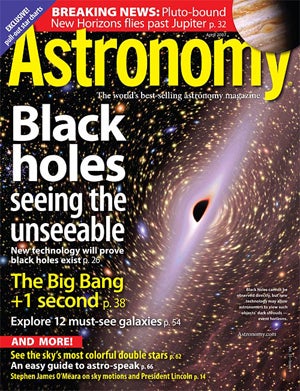
March 5, 2007
WAUKESHA, WI – The universe’s first second saw an unprecedented torrent of creation, the effects of which, we witness still today – 13.5 billion years later.
The April 2007 Astronomy magazine cover story, “Big Bang + 1 second,” lays out what scientists know now about that extraordinary moment and how they plan to learn more. Writer Steve Nadis explains how these scientists use instruments in far-off places – from stations in Antarctica to satellites in space – to study the role of subatomic particles, namely neutrinos, in the Big Bang theory of the universe.
From the theoretical to the observable, Astronomy‘s April issue also features a preview of a NASA spacecraft’s Jupiter flyby. The Pluto-bound New Horizons satellite gets a much-needed speed boost from the solar system’s biggest planet February 28, and the mission’s principal investigator, S. Alan Stern, reveals his team’s day-to-day plans leading up to and following the February 28 pass. These important few days will give Stern and his crew an opportunity to test their spacecraft’s equipment before they put it to sleep for the 7-year trip to Pluto.
While this month’s issue offers readers the chance to go inside the science of their hobby, it also guides readers to April’s observing treats – like a dozen must-see galaxies, double stars, and meteors – for beginning and advanced astronomers alike. Read on for more information about the April 2007 Astronomy.
More resources from Astronomy.com:
Astronomy news
This week’s sky events
Astronomy basics
Glossary of astronomical terms
Return to Astronomy “For the media” page
Astronomy promotes the science and hobby of astronomy through high-quality publications that engage, inform, entertain, and inspire. Big Bang
In its first second, the universe witnessed an explosive rate of expansion known as inflation, the birth of the four fundamental forces (strong, weak, electromagnetic, and gravity), and the creation of a sea of relic neutrinos that is still with us. In “The Big Bang + 1 second,” astronomers search for these primordial neutrinos in order to better understand the origin of the universe.
Pluto or bust
New Horizons, the first mission to Pluto and the Kuiper Belt, rocketed into space in January 2006. Now, just over a year into its flight, the spacecraft nears Jupiter, offering scientists a chance to learn more about this planet and its moons. Jupiter’s gravity will offer New Horizons an additional 9,000 mph (14,000 km/h) speed boost, rocketing it to Pluto by 2015. “New Horizons flies past Jupiter” details the path and purpose of the latest Pluto mission.
Update: New Horizons executed its Jupiter flyby without flaw February 28. Read S. Alan Stern’s exclusive recap on his blog at Astronomy.com.
Seeing the unseeable
How does one prove the existence of an invisible object? Black holes, massive objects that swallow all matter and radiation near them, are, by definition, unseeable. However, astronomers are confident that detecting a black hole’s defining feature – the event horizon – will prove its existence. “Black holes: seeing the unseeable,” enters the realm of the invisible and the abstract, taking black holes from theoretical oddities to virtual certainties.
Also in this issue
- “Explore a dozen must-see galaxies” – Venture off the beaten path to observe twelve extragalactic gems.
- “Observe the sky’s most colorful double stars” – You’ll have no problem seeing these celestial beauties through a small telescope, even through the haze of light pollution.
- “An easy guide to astro-speak” – If you’ve ever wondered about some of the terms astronomers use, here’s an illustrated guide.
- The April 2007 issue also includes Ask Astro, Astro News, Bob Berman’s strange universe, Stephen James O’Meara’s secret sky, Glenn Chaple’s observing basics, Phil Harrington’s binocular universe, The sky this month, New products, and Reader gallery.









